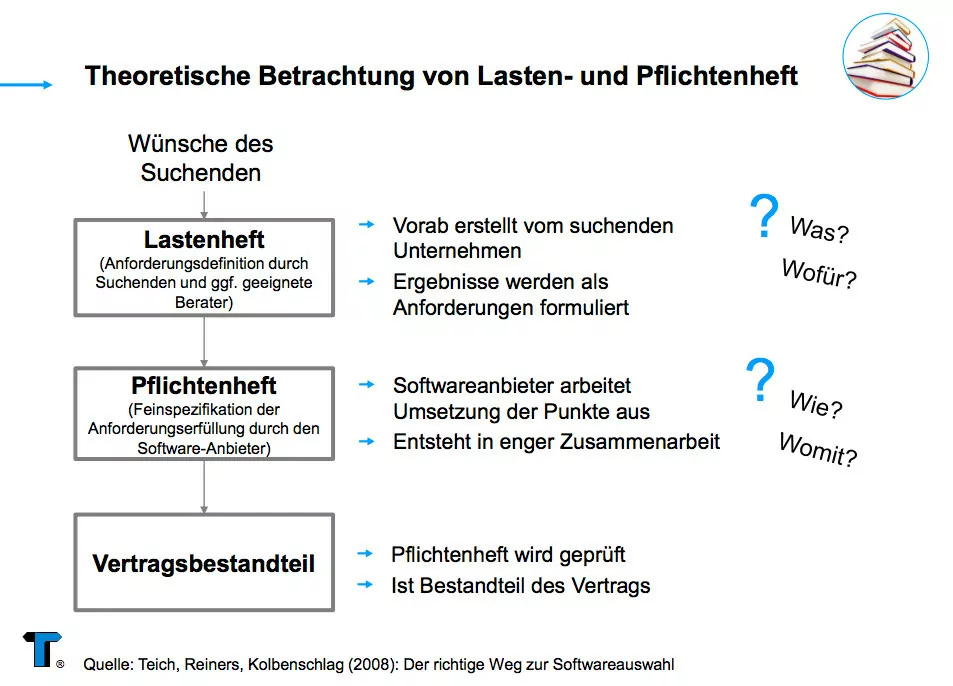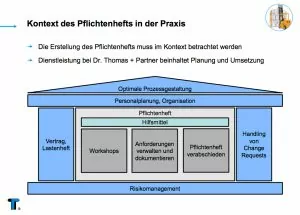The specification sheet generally contains the project requirements predefined and described in detail by the client, which in his or her view are necessary to successfully implement all requirements of the overall project. The requirement document, on the other hand, contains the exact specifications of all target processes, based on the customer requirements predefined in the requirement document, which actually make a smooth project implementation possible. It is prepared by the contractor in cooperation with the customer and is considered a binding form of contract.
Specification sheet
If, for example, a new warehouse management system or its process modules (goods receipt, goods issue, picking, packing, storage) are to be introduced in a company or adapted to new requirements by means of retrofitting, the client first defines the project objectives in the form of a specification sheet. This also includes the requirements for IT, conveyor infrastructure and storage technology (e.g. high bay warehouse, automated small parts storage).
As a rule, the specifications are drawn up by the client during the specification phase. The company analyzes all project-related operating processes, optimization gaps and newly added project requirements, which from the company’s point of view are decisive for the successful completion of the project. Depending on internal structures and legal requirements, the specification phase can last several months. Finally, the client accepts the project documentation (specification sheet) internally and hands it over to the contractor. From this point on, it is referred to as the so-called project conception: the requirements specification phase.
Requirement document
The formulated requirements of the customer are described in detail by the contractor after the requirement phase in the subsequent specification phase. The “what” and “for what” of the customer is combined with a “how” and “with what” of the potential solutions the implementing team outlines. Thus, the requirement document forms the interface between the customer and the service provider and is at the same time the basis of the contractually agreed services. It is therefore considered a binding form of contract.
An important note: All material flow, hardware and software requirements described in the specifications should be formulated in a way that is understandable to the contractor This is one reason why, in some cases, the contractor provides advice to the customer as early as the specification phase. In the course of the transition from the specification phase to the requirements phase, the demands of the client may collide with the viability of the contractor’s side. A smooth communication interface (see communication level below), in which all responsible persons are involved, is therefore key.
The requirement document as the basis for the project realization
As the requirement document is a form of contract that requires approval and official acceptance by the customer, it serves as the basis for the software, hardware, and process-related implementation of a project. Extensive projects often require the segmentation of individual processes in great detail. Depending on the size of the project, these are then divided into individual requirement documents. For example, starting with an area (for example, a high-bay warehouse or an automatic small-parts warehouse) can be described in detail. In the following requirement documents, processes such as putaway, stock removal, inventory management and picking follow.
Note: Each process in itself forms an independent requirement document, which reflects all the sub-topics of the process.
A project team consisting of specialists from both the customer and supplier side is involved in a requirement document during the respective conceptual phase. In the best case, these teams work together until project completion.
On the one hand, there is the team of the process owner, who as the contact person is responsible for the respective processes on the part of the customer. He is also responsible for the timely implementation of individual process steps with regard to compliance with the project duration. On the other hand, the project manager together with his competence team is responsible for implementing the contractually agreed requirements. In order to guarantee these requirements, it is important to involve the implementation manager in a timely manner, as he or she ensures the implementation of the intralogistics processes, for example in software development.
Important: If the customer makes new or deviating requirements after acceptance of the requirement document, these are usually formulated as Change Request (CR) and processed by the contractor according to priority.
Requirements and specifications at the communication level
The realization of a requirement document requires, in addition to the documentation of the project goals, a continuous communication externally as well as internally. To this end, it is advisable to have a regular exchange between the two parties during the specification phase in order to ensure mutual coordination along the design process, for example in the form of workshops. In most cases, both sides work with the same documentation software, which allows, among other things, personalized comment functions.
In summary
The client describes all requirements in the specification sheet and is thereby required to give extensive thought to the overall project. The requirement document describes in detail the entire specifications including possible solutions; it is considered a binding form of contract and is prepared by the contractor. However, its approval is given by the client.
Further information in the context of a system introduction can be found under the article Modularization of conveyor systems.
Teaser image: Erik Scherz Anderson (License: CC BY-SA 2.0)
Source Images: Presentation of the master thesis of Nadine Blattner
Also available in Deutsch (German)

